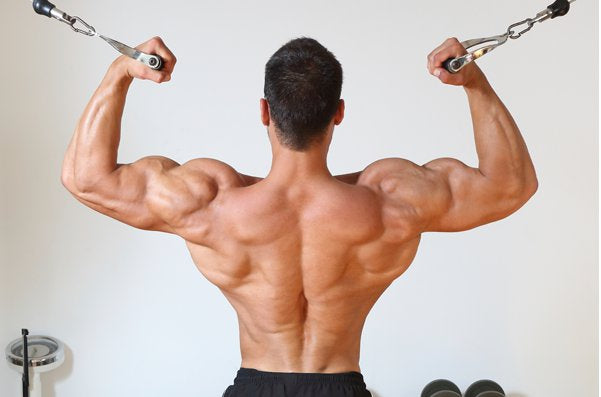The human body is an intricate system of interconnected muscles and bones, and one area that often goes overlooked in fitness is the lower trapezius, or "lower traps." These muscles play a crucial role in maintaining good posture, enhancing upper body strength, and even relieving common aches and pains. In this comprehensive guide, we will explore the anatomy and function of the lower traps, discuss the link between posture and self-confidence, and provide an in-depth look at a variety of lower trap exercises. We'll also delve into the importance of nutrition and recovery for maximizing the benefits of lower trap training.
Anatomy of the Lower Traps
The trapezius muscles are broad, triangular muscles that cover a significant portion of the upper back. The lower traps originate from the spine and attach to the shoulder blades (scapulae). These muscles are responsible for scapular depression and retraction, which are crucial for maintaining proper shoulder and upper back positioning.
Role in Posture and Shoulder Function
The lower traps play a pivotal role in maintaining an upright posture. When these muscles are weak or underdeveloped, it can lead to rounded shoulders and a hunched posture. This not only affects your appearance but can also result in discomfort and pain, particularly in the neck and upper back regions.
Common Problems Associated with Weak Lower Traps
Weak lower traps are often associated with a range of issues, including:
Shoulder Impingement: Weak lower traps can lead to shoulder impingement, a painful condition where the shoulder blade rubs against the rotator cuff tendons.
Neck Pain: Poor posture due to weak lower traps can lead to chronic neck pain.
Reduced Strength: Weak lower traps can limit your upper body strength and hinder performance in activities such as weightlifting and sports.
Loss of Confidence: Poor posture can negatively impact self-esteem and confidence.
Lower Trap Exercises: Basics and Fundamentals
To strengthen your lower traps, it's essential to perform specific exercises that target these muscles. Let's dive into some foundational exercises and stretching techniques.
Warm-Up and Stretching
Before diving into lower trap exercises, it's crucial to warm up and stretch to prepare your body for the workout.
- Incorporate shoulder circles, arm swings, and wall angels to improve shoulder mobility and flexibility.
- Perform upper back stretches such as the "cat-cow" stretch, child's pose, and thoracic spine rotations to increase flexibility and reduce tension in the upper back.
Strengthening Lower Traps
Strengthening your lower trapezius muscles is vital for improving posture, upper body strength, and reducing aches and pains. Let's explore a few key exercises for strengthening the lower traps, along with their benefits and how to perform them.
Prone Scapular Retraction
Benefits
- Prone scapular retractions help correct rounded shoulders by strengthening the lower traps, which play a crucial role in maintaining an upright posture.
- This exercise promotes scapular stability, reducing the risk of shoulder impingement and discomfort.
- It targets the lower traps directly, leading to better muscle balance in the upper back.
How to do it
- Lie face-down on a mat with your arms at your sides.
- Lift your chest and shoulders off the ground while squeezing your shoulder blades together.
- Hold this position for a few seconds, emphasizing the engagement of your lower traps.
- Slowly lower back down, then repeat for several reps.
Face Pulls
Benefits
- Face pulls specifically target the upper back, including the lower traps and rear deltoids.
- This exercise enhances your ability to retract your shoulder blades, contributing to better posture and reduced shoulder issues.
- By working the rear deltoids along with the lower traps, it ensures all shoulder muscles are balanced and functional.
How to do it
- Stand with your feet shoulder-width apart.
- Attach a resistance band or use a cable machine with a rope attachment.
- Pull the rope attachment towards your face while squeezing your shoulder blades together.
- Slowly release the rope, maintaining control.
- Repeat for several reps.
Y-Raises
Benefits
- Y-raises are excellent for isolating and strengthening the lower traps.
- This exercise enhances scapular stability and control, which is essential for good posture.
- It works the upper back muscles, reducing the risk of upper back discomfort and pain.
How to do it
- Lie face-down on an incline bench with a dumbbell in each hand.
- Extend your arms forward and slightly outward to form a "Y" shape.
- Lift the weights while focusing on using the lower traps to lift your arms.
- Slowly lower the dumbbells back down and repeat.
Band Pull-Aparts
Benefits
- Band pull-aparts isolate the lower traps, promoting their development and strengthening.
- Improved Posture Support: Stronger lower traps contribute to better scapular position, helping to maintain an upright posture.
- Scapular Stability: This exercise enhances scapular stability, reducing the risk of shoulder impingement and discomfort.
How to do it
- Stand with your feet hip-width apart, holding a resistance band in front of you.
- Pull the band apart by spreading your arms to the sides, emphasizing the engagement of your lower traps.
- Return to the starting position with control.
- Repeat for several reps.
Dumbbell Rows
Benefits
- Dumbbell rows engage not only the lower traps but also the lats and rhomboids, contributing to a strong upper back.
- By working multiple upper back muscles, it ensures a balanced and functional upper body.
- Strengthening the entire upper back promotes better posture and reduces the risk of discomfort.
How to do it
- Bend at the waist, holding a dumbbell in one hand.
- Pull the dumbbell towards your hip while keeping your elbow close to your body.
- Lower the weight with control.
- Repeat for several reps, then switch to the other hand for balanced development.
Reverse Shrugs
Benefits
- Reverse shrugs directly target the lower traps, contributing to their development.
- Posture Enhancement: Strengthening the lower traps aids in maintaining good posture.
- This exercise helps with scapular stability and shoulder function.
- Stand with your feet hip-width apart.
- Hold a barbell or a set of dumbbells in front of you with an overhand grip.
- Shrug your shoulders upwards and slightly back, emphasizing the engagement of your lower traps.
- Lower your shoulders back down and repeat for several reps.
Farmer's Walk
Benefits
- The farmer's walk engages the entire upper body, including the lower traps.
- This exercise promotes functional strength and stability, which can assist in daily activities.
- Strengthening the entire upper back contributes to better posture.
- Stand with a weight in each hand, such as dumbbells or kettlebells.
- Keep your shoulders back and down, engaging your lower traps.
- Walk for a set distance or time, maintaining an upright posture and focusing on scapular stability.
Incorporating these exercises into your fitness routine can help you build strong and functional lower trapezius muscles, leading to improved posture, enhanced upper body strength, and a reduction in aches and pains. Remember to start with appropriate weights and focus on proper form for the best results while reducing the risk of injury.
Common Mistakes to Avoid
When performing these exercises, be mindful of common mistakes, such as using too much weight, sacrificing form for repetitions, or neglecting the mind-muscle connection with the lower traps. Proper form and controlled movements are essential for effectively targeting these muscles.
Designing Your Lower Trap Workout Plan
Once you are familiar with these exercises, it's essential to create a workout plan tailored to your goals and fitness level.
Setting Clear Goals
Determine whether you want to focus on improving posture, increasing upper body strength, or addressing pain relief. Clear goals will help you structure your routine effectively.
Choosing the Right Exercises
Incorporate a variety of exercises to ensure you target the lower traps from multiple angles and engage surrounding muscles. A well-rounded routine may include some or all of the exercises mentioned above.
Frequency, Sets, and Repetitions
For beginners, aim for 2-3 workouts per week. Perform 3-4 sets of each exercise with 8-12 repetitions. As you progress, you can increase intensity and volume.
Progression and Variation
To continue challenging your lower traps, gradually increase the weight, vary exercises, and incorporate advanced techniques.
The Power of Consistency
Consistency is key when it comes to any fitness routine. Regularly engaging your lower traps through exercises and paying attention to your posture can yield significant long-term benefits.
Consistency is essential because it helps to maintain the strength and endurance of your lower traps. Aim for steady progress rather than quick fixes.
Tracking Progress and Making Adjustments
Keep a workout journal to track your progress. Adjust your workout plan as needed, increasing weight, repetitions, or sets to keep challenging yourself.
Staying Motivated
Staying motivated can be challenging, but visualizing the benefits of strong lower traps, including improved posture, confidence, and reduced pain, can help keep you on track.
Nutrition for Lower Trap Development
Proper nutrition is a critical component of any fitness program, including lower trap development. Here are some dietary considerations to support your goals:
Protein: Protein is essential for muscle repair and growth. Include lean protein sources like chicken, fish, tofu, and legumes in your diet.
Complex Carbohydrates: Carbohydrates provide the energy you need for your workouts. Opt for complex carbs like whole grains, vegetables, and fruits
Healthy Fats: Healthy fats, like those found in avocados, nuts, and olive oil, are important for overall health and can support muscle function.
Hydration: Staying well-hydrated is crucial for muscle function and recovery. Aim to drink plenty of water throughout the day.
Vitamins and Minerals: Certain vitamins and minerals, such as vitamin D, calcium, and magnesium, play a role in muscle function and bone health. Ensure your diet is well-balanced to cover these nutritional needs.
Supplements: Depending on your dietary preferences and needs, you might consider supplements like protein powders, branched-chain amino acids (BCAAs), or multivitamins to fill potential nutritional gaps.
Meal Timing: Consuming a balanced meal with protein and carbohydrates after your workouts can support muscle recovery.
Recovery and Rest for Optimal Results
Rest and recovery are as vital as exercise and nutrition when it comes to achieving your fitness goals, including lower trap development.
Sleep: Aim for 7-9 hours of quality sleep each night. Sleep is when your body repairs and builds muscle.
Active Recovery: Incorporate light activities like walking, yoga, or stretching on rest days to promote blood flow and reduce muscle soreness.
Foam Rolling and Massage: Foam rolling and massage can help alleviate muscle tightness and enhance recovery.
Hydration: Proper hydration is essential for the recovery process. Dehydration can lead to muscle cramps and slower recovery.
Listen to Your Body: Pay attention to signs of overtraining or injury. If you experience persistent pain or discomfort, consult with a healthcare professional.
Mind-Body Techniques: Practices like meditation and deep breathing can reduce stress, which can contribute to faster recovery and muscle growth.
Posture and Pain Relief
Strong lower traps not only enhance posture but can also alleviate common aches and pains that often stem from poor posture. Improving the strength and endurance of your lower traps can help alleviate or prevent various aches and pains:
Shoulder Pain Relief: A stronger lower trapezius can contribute to better scapular control and reduce the risk of shoulder impingement, a common source of shoulder pain.
Neck Pain Reduction: Weak lower traps often lead to a forward head posture, which can strain the neck muscles and result in chronic neck pain. By enhancing your posture, you can mitigate this discomfort.
Mid-Back Comfort: The mid-back region, or thoracic spine, can become stiff and painful when posture is poor. Engaging your lower traps can encourage a more upright posture, alleviating mid-back pain.
Conclusion
In conclusion, mastering lower trap exercises can be a transformative journey that enhances your posture, boosts self-confidence, and alleviates common aches and pains. By understanding the anatomy and function of the lower traps, incorporating the right exercises, maintaining consistency in your training, and focusing on nutrition and recovery, you can unlock your full potential and experience the myriad benefits of strong lower traps.
Remember that proper posture not only influences your physical well-being but also plays a significant role in shaping your self-esteem and overall quality of life. So, take the first step on this empowering journey, and embrace the strength and confidence that come with a strong back, a more confident you, and a body that is well-nourished and adequately rested.










